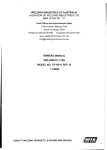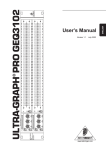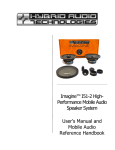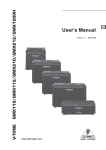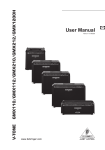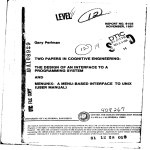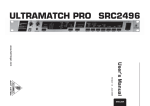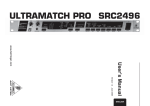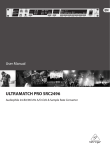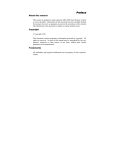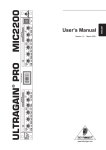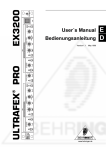Download Behringer SRC2000 User`s manual
Transcript
Bedienungsanleitung Version 1.2 January 1999 ULTRAMATCH SRC2000 User´s Manual www.behringer.de 1 E D EG-Declaration of Conformity Spezielle Studiotechnik GmbH acc. to the Directives 89/336/EWG and 73/23/EWG We, BEHRINGER INTERNATIONAL GmbH Hanns-Martin-Schleyer-Straße 4 D - 47877 Willich Name and address of the manufacturer or the introducer of the product on the market who is established in the EC herewith take the sole responsibility to confirm that the product: ULTRAMATCH SRC2000 Type designation and, if applicable, Article-No which refers to this declaration, is in accordance with the following standards or standardized documents: x EN 60065 x EN 55020 x EN 55013 x EN 61000-3-2 x EN 61000-3-3 x EN 55022 The following operation conditions and installation arrangements have to be presumed: acc. to Operating Manual B. Nier, President Name, address, date and legally binding signature of the person responsible 2 Willich, 01.01.1999 SAFETY INSTRUCTIONS CAUTION: To reduce the risk of electrical shock, do not remove the cover (or back). No user serviceable parts inside; refer servicing to qualified personnel. WARNING: To reduce the risk of fire or electrical shock, do not expose this appliance to rain or moisture. This symbol, wherever it appears, alerts you to the presence of uninsulated dangerous voltage inside the enclosure - voltage that may be sufficient to constitute a risk of shock. This symbol, wherever it appears, alerts you to important operating and maintenance instructions in the accompanying literature. Read the manual. DETAILED SAFETY INSTRUCTIONS: All the safety and operation instructions should be read before the appliance is operated. Retain Instructions: The safety and operating instructions should be retained for future reference. Heed Warnings: All warnings on the appliance and in the operating instructions should be adhered to. Follow instructions: All operation and user instructions should be followed. Water and Moisture: The appliance should not be used near water (e.g. near a bathtub, washbowl, kitchen sink, laundry tub, in a wet basement, or near a swimming pool etc.). Ventilation: The appliance should be situated so that its location or position does not interfere with its proper ventilaton. For example, the appliance should not be situated on a bed, sofa rug, or similar surface that may block the ventilation openings: or placed in a built-in installation, such as a bookcase or cabinet that may impede the flow of air through the ventilation openings. Heat: The appliance should be situated away from heat sources such as radiators, heat registers, stoves, or other appliance (including amplifiers) that produce heat. Power Source: The appliance should be connected to a power supply only of the type described in the operating instructions or as marked on the appliance. Grounding or Polarization: Precautions should be taken so that the grounding or polarization means of an appliance is not defeated. Power-Cord Protection: Power supply cords should be routed so that they are not likely to be walked on or pinched by items placed upon or against them, paying particular attention to cords and plugs, convenience receptacles and the point where they exit from the appliance. Cleaning: The appliance should be cleaned only as recommended by the manufacturer. Non-use Periods: The power cord of the appliance should be unplugged from the outlet when left unused for a long period of time. Object and Liquid Entry: Care should be taken so that objects do not fall and liquids are not spilled into the enclosure through openings. Damage Requiring Service: The appliance should be serviced by qualified service personnel when: - The power supply cord or the plug has been damaged; or - Objects have fallen, or liquid has been spilled into the appliance; or - The appliance has been exposed to rain; or - The appliance does not appear to operate normally or exhibits a marked change in performance; or - The appliance has been dropped, or the enclosure damaged. Servicing: The user should not attempt to service the appliance beyond that is described in the Operating Instructions. All other servicing should be referred to qualifield service personnel. 3 E ULTRAMATCH Provides virtually all possible digital format conversions of professional and consumer modes, AES/EBU, SPDIF coaxial or optical SRC2000 s Accepts sampling frequencies from 25 kHz to 60 kHz s Selectable input (XLR, RCA, optical) s Converts into output frequencies 44,1 kHz or 32 kHz s The output signal format can be specified - No incompatibilities s All outputs (XLR, RCA, optical) are concurrently active (splitter, signal distribution) s Enables manipulation of Emphasis and copy prohibit bits s Transformer balanced In-/ Outputs s No ground loops even through RCA (coaxial) inputs s Reliable operation even on week input signals (as found when using damaged cables) s Removes Jitter and corrects detuned or wrong Sample Rates s Can be used to change incorrect Emphasis coding s Removes copy prohibit bit* s Self configuring digital Anti-Aliasing filter s THD under 0,001%, Noise below -95 dBFS s Universal external synchronization via separate Wordclock input s Extremely fast tracking allows even for Varispeed applications s Automatically resynchronizes varying sample rates s Master units (CD-Player, DAT) can be used in slave mode s Corrects unformatted passages on DAT and other media s Manufactured under the stringent ISO9000 management system * At this point we would like to point out that, in spite of the possibility to remove the copy prohibit bit, authorand copyrights always have to remain preserved. This device was not developed to create illegal copies! 4 FOREWORD Dear Customer, Welcome to the BEHRINGER ULTRAMATCH and thank you for placing your trust in BEHRINGER products. My most pleasant task is to write this letter to you, because it is the culmination of many months of hard work for our engineering team. Our daily objective is to be focused on you, the musician and sound engineer, and with that focus in mind, it drives us to reach a goal which is unique, and is the backbone of the BEHRINGER philosophy. It is our philosophy to share our joy with you, because you are the most important member of the Behringer family. With your highly competent suggestions for new products youve greatly contributed to shaping our company and making it successful. In return, we guarantee you uncompromising quality (manufactured under the stringent quality system ISO9000) as well as excellent technical and audio properties at an extremely favorable price. All of this will enable you to fully unfold your creativity without being hampered by budget constraints. We are often asked how we can make it to produce such high-grade devices at such unbelievably low prices. The answer is quite simple: its you, our customers! Many satisfied customers means large sales volumes enabling us to get better conditions of purchase for components, etc. Isnt it only fair to pass this benefit back to you? Because we know that your success is our success, too! I would like to thank all the people, whose help on the ULTRAMATCH has made it all possible. Everybody has made very personal contributions, starting from the designers of the unit via the many staff members in my company to you, the user of BEHRINGER products. Thank you and sincerely yours, Uli Behringer 5 E TABLE OF CONTENT 1. INTRODUCTION ...................................................................................................................... 7 1.1 Some Words on Digital Sample Rate Conversion ........................................................................... 7 1.2 The AES/EBU and SPDIF Standards .............................................................................................. 7 2. THE CONCEPT ........................................................................................................................ 9 2.1 The Quality of Components and Circuits ......................................................................................... 9 2.2 Digital Inputs and Outputs ............................................................................................................... 9 2.2.1 XLR ...................................................................................................................................... 9 2.2.2 RCA ...................................................................................................................................... 9 2.2.3 Optical (TOSLINK) ................................................................................................................ 9 2.2.4 Wordclock (BNC) ............................................................................................................... 10 3. INSTALLATION ...................................................................................................................... 11 3.1 Rack Mounting ............................................................................................................................... 11 3.2 Mains Connection .......................................................................................................................... 11 3.3 General Instructions on Connections ............................................................................................. 11 3.3.1 Balanced XLR Connection (AES / EBU) .............................................................................. 11 3.3.2 Unbalanced Coaxial Connections (SPDIF) ......................................................................... 12 3.3.3 Optical Connections (SPDIF) ............................................................................................. 12 3.3.4 Wordclock .......................................................................................................................... 13 3.3.5 Connections with Adapters .................................................................................................. 14 4. CONTROLS AND FUNCTIONS .............................................................................................. 15 4.1 Front Panel ................................................................................................................................... 4.1.1 Input Section ...................................................................................................................... 4.1.2 LED-Display ....................................................................................................................... 4.1.3 Output Section .................................................................................................................... 4.2 Rear Panel .................................................................................................................................... 15 15 16 17 17 5. MODE OF OPERATION ......................................................................................................... 18 5.1 5.2 5.3 5.4 Basic Settings ............................................................................................................................... Elimination of Errors ..................................................................................................................... Conversion to 32 kHz .................................................................................................................... Emphasis Correction .................................................................................................................... 18 18 18 18 6. APPLICATIONS ..................................................................................................................... 19 6.1 Sample Rate Conversion ............................................................................................................... 19 6.1.1 Operation in a DAT-Based Studio ....................................................................................... 19 6.1.2 Harddisk Recording ............................................................................................................ 19 6.1.3 Reduction of Memory Requirements ................................................................................... 19 6.1.4 Master/Slave Conflicts ........................................................................................................ 19 6.1.5 Correction of unformatted passages ................................................................................... 20 6.2 SCMS Removal ............................................................................................................................. 20 6.3 Line Booster, Signal Refresher ..................................................................................................... 20 6.4 Sample Rate Correction ................................................................................................................ 20 6.5 Varispeed Applications .................................................................................................................. 21 6.6 Format Conversion ....................................................................................................................... 21 6.7 Format Interface ........................................................................................................................... 21 6.8 Patchbay/Split Operation .............................................................................................................. 21 6.9 The ULTRAMATCH in a home-recording studio ............................................................................. 21 7. SPECIFICATIONS .................................................................................................................. 23 8. WARRANTY ........................................................................................................................... 25 6 1. INTRODUCTION BEHRINGER ULTRAMATCH is an essential tool for modern recording studios. The importance of digital technology has grown immensely during the past years in home-recording as well as in semi-professional and professional studios. More and more operations are executed on the digital level. As a result, sound engineers and musicians are confronted with a multitude of new connectors, signal leads, and changed standards. Incompatibilities between two different devices are normal, and very often it turns out to be impossible to interconnect two devices from different manufacturers. This situation made us develop the ULTRAMATCH - a multi-functional device that meets all the requirements modern studios expect. The ULTRAMATCH combines functions such as a digital patchbay, a signal refresher, an SCMS eraser, a jitter killer, a format converter, and an excellent sample rate converter within a single unit. Nevertheless, it is extremely user-friendly. 1.1 Some Words on Digital Sample Rate Conversion Up to now, the conversion of various sample rates has necessitated an enormous amount of components, and yet has had manifold drawbacks, resulting in measurable signal falsifications such as increased noise, distortion, or unwanted mirror frequencies (high-frequency chirping). The new processor employed in the ULTRAMATCH executes a real-time conversion with total precision. It works absolutely stealthily, and its influence on the signal can be detected only by means of very expensive measuring instruments. Let´s look at a model to explain this operation which describes the conception of interpolation and decimation of sample points. The processor performs an oversampling on the input signal, i. e. further samples are set between each two regular samples, resulting in a larger total number of samples by this filling of the gaps. An equivalent oversampling with a factor of 65,536 corresponds to an internal sample rate of 3.2768 GHz. Afterwards, the signal is run through a variable low-pass filter, ensuring a correct aliasing limit. This process is started automatically whenever the sample rate at the output falls below the one at the input. Then, the number of sample points is reduced by division until the desired sample rate can be established at the output. Due to this enormous oversampling, the processor operates accurately over the entire audio-frequency band. Simultaneously, any jittering present in the input signal is removed. No doubt, digital signal processing provides extremely low THD and noise values. However, signal recalculation especially in sample rate conversion used to lead to considerably non-linear results which is not surprising. The amount of data created in the interpolation model described above would totally overstrain conventional technology. 10 Mbytes of data per minute would have to be stored in standard stereo sampling. Multiplied by 65,536, there would be a data amount of 650 Gbytes! Even if this data were processed in small packages in order to avoid storage problems, sensible operation would be impracticable. Therefore, programmers have developed various algorithms that always used to be only a compromise between arithmetic expenditure and sound quality. However, despite real-time data processing, the BEHRINGER ULTRAMATCH obtains fantastic results. The achieved noise level is below -120 dBFS and the distortion values are below -95 dBFS even at most complex input signals. That means that the processing executed by the ULTRAMATCH remains inaudible, since neither conventional A/D and D/A converters nor the final product - the CD - can achieve approximate values. 1.2 The AES/EBU and SPDIF Standards During the past decade, two standards have been established for digital audio transmission (see table 1.1). The AES/EBU standard defines a professional balanced connection with XLR connectors, whereas the semiprofessional SPDIF standard (developed by Sony and Philips) makes use of RCA or optical connections with light conductors. However, the SPDIF method standardized in IEC 958 has rather become known for its notorious copy protection. 1. INTRODUCTION 7 E Type Connection Mode of operation Impedance Level Clock Accuracy Jitter AES / EBU XLR Balanced 110 Ohms 0.2 V to 5 V pp not defined ± 20 ns IEC 958 (SPDIF) RCA / Optical Unbalanced 75 Ohms 0.2 V to 0.5 V pp I: ± 50 ppm II: 0,1 % III: Variable Pitch not defined Tab. 1.1: Important characteristics of the AES/EBU and IEC 958 standards. Unfortunately, these standards soon became watered-down, since a lot of devices simply did not provide enough space for XLR jacks. In these units, either TRS jacks, mini jacks, or special adapters for Sub-D connectors were employed. Besides the electrical differences, the physical realizations of the interface concepts are slightly different. The audio information is transmitted identically, meaning that in principle both formats are compatible. However, there are varying data blocks depending on which format is used. Table 1.2 represents an extract from the data structure of the AES/EBU standard, table 1.3 shows the corresponding data in SPDIF format. It is just the first bit that defines the following ones as a professional-type or consumer-type data stream. It is obvious how the following bits differ in meaning. If a device such as a conventional DAT recorder features only an SPDIF input, it will accept only SPDIF data. When receiving professional-type data, the data reception is usually terminated since AES/EBU signals would lead to malfunctions in copy protection and emphasis if processed by a consumer-type device. The problem is common to many plug-in connections. A lot of devices do not switch off transmission, others process both formats though equipped with just one interface type, and finally there are some that are simply faulty, refusing to operate correctly though the correct identification is received. The ULTRAMATCH is able to solve any of these problems. Whatever is received by the unit is transmitted from its output as a signal with correct identification in the selected format. Byte 0 1 2 3 4 5 Bit 1 2 3 4 5 6 7 Audio? Emphasis Locked Sampl. Freq. Channel Mode Use of User bits Use of AUX bits Length of audio sample Reserved Reserved for description of multichannel recording Audio reference Reserved Reserved 0 P/C Tab. 1.2: Identifying Information in Professional Format Byte 0 1 2 3 0 P/C Bit 2 3 4 5 6 7 Emphasis Mode Copy Category code Gen.St. Source number Channel number Sampling frequency Clock accuracy Reserved 1 Audio? Tab. 1.3: Identifying Information in Consumer Format 8 1. INTRODUCTION 2. THE CONCEPT The BEHRINGER ULTRAMATCH is an especially flexible device meeting all the requirements of digital applications. Compared to most conventional sample rate converters, the ULTRAMATCH offers much more than mere sample rate conversion, due not only to various options for signal manipulation but also the provision of the complete input and output interface. The front panel of the ULTRAMATCH is strictly functional and has a user-oriented design. The nature of the input signal and the selected mode of processing can be identified plainly. An separate error LED indicates the presence of a valid input signal, another LED points to a set emphasis bit. Since the ULTRAMATCH automatically synchronizes to any input signal with a sample rate between 25 kHz and 60 kHz, no selector is necessary for the input sample rate. A convenient feature is the manipulation of a set emphasis bit which means that the audio signal is not changed, but only the identification contained in the digital data flow. You will usually activate the auto function that automatically passes the emphasis information through. In theory, this is standard because sound material recorded with (pre-) emphasis (fixed high-frequency boosting) has to be replayed with (de-) emphasis (fixed high-frequency cut) in order to avoid falsifying the signal. In every-day studio life, however, it may be different. It is known that sometimes during mastering and cutting processes, the emphasis bit is set by defect hardware or software, though no high-frequency boosting is executed. Usually, this error remains unnoticed during the duplication process since most modern DAT recorders do not provide an emphasis indicator anymore. The subsequent delivering of the DAT tape becomes a rude awakening for the customer: The high-frequency cutting cannot be repaired anymore, and the sound quality is characterized by the absence of any brilliant high frequencies. That is why we provided the ULTRAMATCH with a special emphasis indicator as well as with a selector that allows to correct the emphasis bit manually. 2.1 The Quality of Components and Circuits Due to our companys philosophy we only employ perfectly developed circuits and first-choice components. The heart of the ULTRAMATCH is a special SRC processor that dues to its specifications and excellent sound quality can be referred to as one of the best components ever used in digital processing. Additionally, lowtolerance resistors and capacitors, high-quality transmitters and switches, special digital circuits, and further carefully selected components are employed. 2.2 Digital Inputs and Outputs 2.2.1 XLR The digital XLR inputs and outputs are not limited to the AES/EBU standard. They send and receive data in either professional and consumer format. It is even possible to connect the RCA output of a CD player, for example, to the XLR input of the ULTRAMATCH by means of an adapter(if for example the RCA input is connected to another device in a fixed installation). 2.2.2 RCA The digital RCA inputs and outputs are not limited to the SPDIF standard. They send and receive data in either professional and consumer format. It is even possible to connect the XLR output of the BEHRINGER ULTRA-CURVE PRO DSP8024, for example, to the RCA input of the ULTRAMATCH by means of an adapter. The opposite (RCA output of the ULTRAMATCH to an XLR input of another device) depends on the sensitivity of the XLR input concerned but should also normally work without problems. 2.2.3 Optical (TOSLINK) The optical inputs and outputs are not limited to the SPDIF standard. They send and receive data in either professional or consumer format. + Note: Many low-end devices require the consumer format sent by the ULTRAMATCH, otherwise they will not accept the signal. 2. THE CONCEPT 9 E + Note: The ADAT multi-track format is not supported by the ULTRAMATCH and is therefore neither passed through nor converted (ADAT is a registrated trademark of Alesis Corp.). 2.2.4 Wordclock (BNC) The BNC jack on the rear panel allows to connect the ULTRAMATCH to a wordclock source for synchronization purposes (s. a. 3.3.4). Wordclock signals are normally distributed in network technology, i. e. they are passed through with BNC-T adapters and terminated with appropriate resistor elements. In order to provide maximum flexibility, the BNC input of the ULTRAMATCH features a high-impedance resistor and is not equipped with the normal terminal resistor (75 Ohm). 10 2. THE CONCEPT 3. INSTALLATION Your BEHRINGER ULTRAMATCH was carefully packed in the factory and the packaging was designed to protect the unit from rough handling. Nevertheless, we recommend that you carefully examine the packaging and its contents for any signs of physical damage, which may have occurred in transit. + If the unit is damaged, please do not return it to us, but notify your dealer and the shipping company immediately, otherwise claims for damage or replacement may not be granted. Shipping claims must be made by the consignee. 3.1 Rack Mounting The BEHRINGER ULTRAMATCH fits into one standard rack unit of space (1 3/4"). Please allow at least an additional 4" depth for the connectors on the back panel. + Be sure that there is enough air space around the unit for cooling and please do not place the ULTRAMATCH on high temperature devices such as power amplifiers etc. to avoid overheating. 3.2 Mains Connection The mains connection of the ULTRAMATCH is made by using a mains cable and a standard IEC receptacle. It meets all of the international safety certification requirements. Please make sure that all units have a proper ground connection. For your own safety, it is advisable not to remove the ground connection within the units or at the supply, or fail to make this connection at all. + Before you switch on the unit, check that it is configured to match your AC mains voltage requirements. If it does not comply, then it is necessary to switch the operating voltage to the correct supply requirements BEFORE turning on the unit, otherwise the unit could be severely damaged. You will find this combined fuse holder/voltage selector at the back, adjacent to the IEC receptacle. Please note that the AC voltage selection is defined by the position of the fuse holder. If you intend to change the operating voltage, remove the fuse holder and twist it by 180 degrees before you re-insert it. Matching the two markers monitors the selected voltage. If the safety fuse is faulty and needs replacing after the unit is repaired, please make sure that you replace it only with the identical type and rating. NEVER use fuses of different ratings or cover faulty fuses with aluminium foil. This can cause fire and electric shocks and will endanger your life and the lives of others. 3.3 General Instructions on Connections The digital input and output connections of the ULTRAMATCH are short-cut protected and transformer-balanced. This means that humming caused by additional ground leads is eliminated even when using the RCA jacks. Additionally, the concept of balanced inputs and outputs allows an operation with adapters, meaning that a signal send from an XLR output can be transmitted to the RCA input of another device without any difficulties. + Please ensure that only qualified persons install and operate the ULTRAMATCH. During installation and operation the user must have sufficient electrical contact to earth. Electrostatic charges might affect the operation of the ULTRAMATCH! 3.3.1 Balanced XLR Connection (AES / EBU) The figure below shows how to connect the balanced inputs and outputs correctly. Basically, the connections are identical to balanced audio connections (for example, when connecting a microphone to a mixing console). Good results have been achieved independently of the selected cable. We recommend to use conventional mic cables with a length of less than 20 m. For longer distances or exacting demands (outdoor applications, strong HF fields), use a special cable with 110 Ohm impedance and double shielding. 3. INSTALLATION 11 E unit A output AES/EBU 2 ULTRAMATCH input signal flow 1 1 3 cable shield 2 3 Fig.3.1: Balanced Connections (AES / EBU) to the ULTRAMATCH 3.3.2 Unbalanced Coaxial Connections (SPDIF) The figure below shows how to connect the unbalanced inputs and outputs correctly by means of RCA cables. Basically, the connections are identical to unbalanced audio connections in stereo systems, for example when connecting a CD player to an amplifier. Good results have been achieved independently of the selected cable. We recommend to use conventional line cables with a length of less than 10 m. However, for longer distances or exacting demands, use XLR or TOSLINK cables. signal flow unit A output S/PDIF ULTRAMATCH input tip tip sleeve shield cable sleeve Fig.3.2: Unbalanced Connections (SPDIF) to the ULTRAMATCH 3.3.3 Optical Connections (SPDIF) The figure below shows how to connect the optical inputs and outputs correctly. The optical system called TOSLINK makes use of other connectors than the ones employed in light wave conduction, though the systems are basically identical. Optical connections are naturally unaffected by electric interference, easy to connect, and amazingly rugged. Unfortunately, they are said to cause extremely high jittering in the data stream, thus decreasing the sound quality of the decoded audio signal significantly although this fairy tale has not been proved yet. What is more, optical connections do not cause any jittering even at cable lengths of 10 m (whereas in practice there are often problems caused by transition resistors in RCA plugs or damaged cables). The real problems of distribution of standard (and customized) cables and their excessive prices. 12 3. INSTALLATION unit A optical output S/PDIF signal flow ULTRAMATCH optical input E Fig. 3.3: Optical Connection via TOSLINK (SPDIF) to the ULTRAMATCH 3.3.4 Wordclock The figure below shows how to connect the unbalanced wordclock input correctly. Basically, the connection is identical to those used in computer network wiring. Actually, the necessary accessories (T-adapters, terminal resistors) are available at most computer dealers. Usually, ready-made BNC cables are used for the connection. The ULTRAMATCH does not include a terminal resistor, so if it is the last unit in a chain, a T-adapter has to be connected to the BNC jack. Then, a terminal resistor (a short BNC plug, 75 Ohm) has to be put on one end of the T-adapter, the BNC cable of the master device has to be connected to the other end. signal flow terminal resistor wordclock output unit A wordclock input ULTRAMATCH Fig. 3.4: Termination Connection of the Wordclock Input of the ULTRAMATCH If the ULTRAMATCH is connected within a chain of devices synchronized via wordclock, then the wordclock signal is input by means of a T-adapter. It is then passed through to the next unit within the chain by means of another BNC cable connected to the other end of the T-adapter. The last unit at the end of the chain has to be terminated by means of a T-adapter and a terminal resistor, as described above. Some devices are provided with a switchable terminal resistor. In this case, T-adapter and terminal resistor are omitted. signal flow other units wordclock output unit A wordclock input ULTRAMATCH Fig. 3.5: Passing through connection of the Wordclock Input of the ULTRAMATCH 3. INSTALLATION 13 3.3.5 Connections with Adapters In some cases, it may be appropriate to connect the inputs and outputs of the ULTRAMATCH to other devices by means of adapter units. For example, if you want to connect two DAT recorders to the ULTRAMATCH at the same time, and each of these recorders features only an SPDIF interface (RCA), you can easily connect one of these recorders to the ULTRAMATCH by means of an RCA-XLR adapter. The figure below shows e. g. the correct wiring of the adapter cables for input connection. unit A output S/PDIF ULTRAMATCH input signal flow tip 1 2 3 sleeve shield cable Fig. 3.6: Adapter Wiring for RCA Output to ULTRAMATCHs XLR Input 14 3. INSTALLATION 4. CONTROLS AND FUNCTIONS 4.1 Front Panel E Fig. 4.1: Controls on the ULTRAMATCHs Front Panel 1 INPUT Section. Each of the three switches to the left activates the respective input. 2 LED-Display. The clearly organized display, located in the center of the front panel, indicates the status of the input signal, the selected synchronization type, and the status of the output signal. 3 OUTPUT Section. The four switches to the right of the front panel allow to select the format of the output signal and the synchronization type. 4.1.1 Input Section 4 5 6 Fig. 4.2: Controls of the Input Section 4 SPDIF Switch. Pressing this switch activates the SPDIF input (RCA) on the rear panel. 5 AES/EBU Switch. Pressing this switch activates the AES/EBU input (XLR) on the rear panel. The switch has priority over to the SPDIF switch. 6 OPTICAL Switch. Pressing this switch activates the optical input (TOSLINK) on the rear panel. The switch has priority over the SPDIF and AES/EBU switches. 4. CONTROLS AND FUNCTIONS 15 4.1.2 LED-Display 7 9 8 10 12 13 15 17 11 14 16 18 19 20 Fig. 4.3: The Indicators of the LED Display Section 7 SPDIF Indicator. When the SPDIF input is activated, this LED is lit. 8 AES/EBU Indicator. When the AES/EBU input is activated, this LED is lit. 9 OPTICAL Indicator. When the optical input is activated, this LED is lit. 10 ERROR Indicator. When the input signal is faulty, this LED is lit. It indicates several malfunctions such as No Lock, Parity, CRC, Valid, etc. When the LED is lit, the ULTRAMATCH is unable to process the input signal. 11 EMPHASIS Indicator. When the emphasis bit in the input signal is set, this LED is lit. 12 INTERNAL Indicator. When internal synchronization is activated, this LED is lit. The output sample rate of the audio signal can be selected with the SAMPLE FREQ switch. 13 EXTERNAL Indicator. When the SYNC switch is depressed, this LED is lit. The output sample rate of the audio signal coincides with the rate present at the wordclock input. 14 LOCK Indicator. This LED is lit when a valid signal is present at the wordclock input and the ULTRAMATCH has locked to this signal. 15 44.1 kHz Indicator. When the SAMPLE FREQ switch is not depressed, this LED is lit. In this case, the sample rate of the output signal is 44.1 kHz. 16 32 kHz Indicator. When the SAMPLE FREQ switch is depressed, this LED is lit. In this case, the sample rate of the output signal is 32 kHz. 17 AUTO Indicator. When the EMPHASIS switch is not depressed, this LED is lit. The emphasis information received is passed through to the output without change. 18 NO EMPHASIS Indicator. When the EMPHASIS switch is depressed, this LED is lit. The emphasis information received is not passed through to the output, meaning that it is deactivated.. 19 PROFESSIONAL Indicator. When the FORMAT switch is not depressed, this LED is lit. This corresponds to the channel status set on the output signal. 20 CONSUMER Indicator. When the FORMAT switch is depressed, this LED is lit. This corresponds to the channel status set on the output signal. 16 4. CONTROLS AND FUNCTIONS 4.1.3 Output Section 21 22 23 24 E Fig. 4.4: Controls of the Output Section 21 SYNC Switch. Pressing this switch allows you to synchronize the ULTRAMATCH from an external source connected to the wordclock input on the rear panel. 22 SAMPLE FREQ Switch. Set the output sample rate to 44.1 kHz or 32 kHz with this switch. + If the mode EXTERN SYNC has been selected, set this switch to the sample rate of the wordclock signal to assign the correct sample rate information (32 kHz or 44.1 kHz) to the output signal! The audio signal will be sent to the output with the sample frequency of the external wordclock signal, but the sample frequency bit (see 1.2) is set to the position of the SAMPLE FREQ switch. 23 EMPHASIS Switch. Use this switch to select, whether the emphasis information received at the input is transmitted to the output (AUTO), or if the emphasis is always switched off at the output (NO EMPHASIS). 24 FORMAT Switch. Use this switch to select the output format of the ULTRAMATCH defined in the channel status data. You can choose either AES/EBU or SPDIF. 4.2 Rear Panel 25 28 29 27 26 Fig. 4.5: Controls on the ULTRAMATCHs Rear Panel 25 MAINS CONNECTOR and FUSE HOLDER/VOLTAGE SELECTOR. Please use the enclosed mains cable to connect the unit to the mains power supply. Please take a look at the chapter INSTALLATION for further information. For replacing the safety fuse, always use the same type. 26 Serial Number. Put the instruction manual in a safe place and return the completed warranty registration card to us within 14 days of purchase, making sure that the dealer stamp has been acquired. 27 INPUTS. These are the three inputs of the ULTRAMATCH. 28 OUTPUTS. These are the three outputs of the ULTRAMATCH. 29 EXT SYNC IN. Connect an external wordclock source to this BNC socket for synchronization purposes. 4. CONTROLS AND FUNCTIONS 17 5. MODE OF OPERATION The ULTRAMATCH is an all-purpose device for modern recording studios. It provides not only sample rate conversion but also format and standard conversion, and additionally allows you to manipulate part of the information transmitted with the audio signal. The ULTRAMATCH features no bypass mode, since input and output signal are practically identical if the same sample rate is applied to both input and output. + Note: Special data formats for backup purposes, that do not contain audio data (streamer applications etc.) cannot be processed with the ULTRAMATCH. 5.1 Basic Settings When powered up, the ULTRAMATCH automatically generates a basic setting suitable for most applications, thus relieving the user from unnecessary work. The input to be activated is automatically selected by a simple priority logic, and the active mode of operation is indicated by the corresponding LED. 5.2 Elimination of Errors The ERROR LED indicates if a valid signal is recognized at the input of the ULTRAMATCH. If a device connected to the output of the ULTRAMATCH does not work properly, the wrong format has probably been selected. Change the format of the output signal by pressing the FORMAT switch. 5.3 Conversion to 32 kHz Though 44.1 kHz is a generally accepted standard for digital audio signals, there are good reasons for converting the signal to 32 kHz: This sample rate is not only compelling for some applications (digital broadcasting systems, long-play mode) but also necessary if memory is critical (one minute of sample data requires only 7 Mbytes instead of 10 Mbytes). 5.4 Emphasis Correction If the EMPHASIS switch is set to AUTO, the emphasis information is transmitted to the output as received at the input. If the emphasis bit is wrongly set due to incorrect pre-processing or defective software or hardware, press the EMPHASIS switch to suppress the output of the emphasis information. The EMPHASIS LED indicates if an emphasis-coded signal is received at the input. 18 5. MODE OF OPERATION 6. APPLICATIONS The universal full-function concept of the ULTRAMATCH allows plenty of applications. It turns out to be an ultimate tool, providing useful solutions for almost any problem. The power of the ULTRAMATCH is accessible via a simple and intelligible user-interface, allowing quick and easy operation. 6.1 Sample Rate Conversion No matter what kind of material is received, the ULTRAMATCH converts it to a standard format. In every-day studio life, lots of possible applications are imaginable: s conversion from 48 kHz (DAT recordings) to 44.1 kHz (CD standard rate); s conversion from 44.056 kHz (old-standard digital recordings) to 44.1 kHz (CD standard rate); s conversion from 32 kHz (non-CD standard material) to 44.1 kHz (CD standard rate). 6.1.1 Operation in a DAT-Based Studio Only recently, inexpensive DAT recorders have been introduced that are able to record analog signals directly with a sample rate of 44.1 kHz. Most DAT recorders, however, only allow recordings with a sample rate of 48 kHz. Usually, such recordings have to be re-recorded then from the consumer DAT recorder to a professional recorder via analog connections. The necessary D/A and A/D conversions lead to an unwanted deterioration in quality of the original material. The use of the ULTRAMATCH eliminates this problem by converting the sample rate on the purely digital level, resulting in a significantly higher quality of the audio material. Other inconveniences, such as incompatible identifications, wrong formats, or an unstable sample rate, are corrected by the ULTRAMATCH in real-time. Thus, the ULTRAMATCH allows real high-quality re-recordings. 6.1.2 Harddisk Recording Harddisk recording applications require a uniform sample rate, preferably the one used by the medium to be employed (i.e. the CD). In this case, too, the ULTRAMATCH allows re-recordings on the digital level by a conversion from sources with a rate of 32 kHz or 48 kHz to the standardized 44.1 kHz. Of course, the ULTRAMATCH can be inserted anywhere in the signal path, even between a computer and the DAT recorder. In non-critical applications, the material can be edited with the computer with a rate of 32 kHz and then be converted to 44.1 kHz while recording it to DAT. 6.1.3 Reduction of Memory Requirements One minute material sampled with a rate of 44.1 kHz requires about 10 Mbytes memory. If the sample rate was reduced down to 32 kHz, only 7 Mbytes of data would have to be stored. When large amounts of audio material have to be recorded or backed up, a lot of memory and costs can be saved. The steep-curved digital filter integrated in the SRC processor of the ULTRAMATCH and the high-quality processing of the input material often allows a conversion to 32 kHz without any audible deterioration in quality. Non-critical material (especially radio or video spots, sound archives, etc.) remains almost unchanged in sound when the transmission rate is limited to 15 kHz, thus remaining entirely fit for later use with regard to the purpose it was recorded for. The integrated digital filter operates with significantly better results than comparable filters in A/D converters, leading to a purer and more transparent sound than direct recordings with a sample rate of 32 kHz. We recommend: Just try it! 6.1.4 Master/Slave Conflicts Master/slave conflicts occur at the latest when a digital mixing console is employed. There is a simple explanation: In normal configurations with CD players, DAT recorders, and hard disk recorders, the replaying device is the master, the recording one acts as slave. When the CD player transmits a signal with a rate of 44.1 kHz, the recording DAT device automatically synchronizes. If a mixing console is inserted between CD player and DAT recorder, the CD player will the master device and the console the slave device. However, the connected DAT player is used for recording as well as for playing 6. APPLICATIONS 19 E the model collapses! The mixing console can only lock to one master source, the audio data received from the other device would be processed wrongly since no synchronization data are available. The only thing one would hear is interference. The synchronization requirements in a digital studio can be met by connecting a central sync master. For instance, the mixing console may act as master and controls all other devices by transmitting a reference code (word clock). However, this is only possible if any slave device in the network features a sync input. In a recording studio with digital recording devices, digital effect units, and hard disk recording systems, conventional CD players and DAT recorders cannot be connected to the mixer since they do not provide synchronization facilities. The ULTRAMATCH solves this problem by defining any connected device as slave if the external sync input is used. It acts as interconnection, and the transmission ratio of 65536:1 always provides a gap in the gear. The signal received from the device to be synchronized is re-synchronized to the wordclock source during the sample rate conversion (see also 1.1). Thus, any device in a studio with central sync source can be connected to any other device via the ULTRAMATCH independently of the original abilities. + In this mode of operation, the setting of the SAMPLE FREQ switch has no effect on the sample rate, but an identifying information (32 kHz or 44.1 kHz) is generated as part of the output signal! This is important since DAT recorders cannot be switched over to record mode if a wrong sample rate is recognized. 6.1.5 Correction of unformatted passages Especially with DAT recorders it can happen that due to bit by bit recordings there remain gaps of the formatted stream between the several recordings. In addition to that often short rests of samplerate information remain on the tape when old recordings are taped with new material. In these cases the ULTRAMATCH converts the peaces of information in a reliable stream of data with a fixed sample frequency. Even if the DAT recorder or any other digital source is stopped or switched off, the ULTRAMATCH continues producing a constant signal (of course without audio information). 6.2 SCMS Removal The copy protection originally included in DAT recorders was simple yet effective: recordings from CD were not possible on the digital level. Later, the SCMS standard was introduced, allowing at least one single digital copy. The action of SCMS depends on the generation (i. e. how many copies have been drawn previously) and the origin (category) of the digital audio material. In professional recording, copy protection makes no sense (actually, no copy protection has been defined as part of the AES/EBU standard). Since a lot of recording studios employ inexpensive consumer devices, problems related to copy protection and differences in format (consumer vs. professional) are a daily occurrence. The ULTRAMATCH ignores any SCMS information and generates a new, entirely SCMS-free information, thus allowing multiple copies on the digital level. Therefore, the ULTRAMATCH may also serve as an aid between two consumer DAT recorders. + At this point we would like to point out again that, in spite of the possibility to remove the copy prohibit bit, author- and copyrights always have to remain preserved. This device was not developed to create illegal copies! 6.3 Line Booster, Signal Refresher Long cables or the use of a patchbay often lead to a deterioration in signal quality, resulting in increased noise or even a connection breakdown. Due to a special input circuitry, the ULTRAMATCH removes jittering, interference, and level drops, and transmits a perfect output signal. Hence, the ULTRAMATCH can also be used to refresh signals affected by long cables or to reconstruct weak and falsified signals. 6.4 Sample Rate Correction The sample rate of a device is often subject to slight deviations due to environmental temperature and aging. Normally, an automatic interception circuit (PLL) corrects unsteady and slightly deviating rates, thus providing trouble-free operation. However, if such deviations exceed a certain limit, the receiving unit cannot synchronize 20 6. APPLICATIONS to the transmitted rate and automatically cancels operation. With the ULTRAMATCH, such restrictions are history. Correct operation is provided not only for a limited range around the selected sample rate but for any sample rate between 25 kHz and 60 kHz. Moreover, the signal transmitted by the ULTRAMATCH is always synchronized to a correct rate of 44.1 kHz or 32 kHz. Therefore, deliberately changed sample rates (for instance, by a varipitch function provided in samplers and certain CD players) as well as too unsteady rates can be corrected by the ULTRAMATCH and processed further. 6.5 Varispeed Applications There may be several reasons to apply a change in speed to a digital recording, for example pitch change or synchronization to other devices. In such cases, the ULTRAMATCH locks to changes in sample rates and transmits the output signal with a fixed rate of 44.1 kHz or 32 kHz. Thus, it reliably solves any problems related to unsteady sample rates in a multi-unit network which else would make digital processing of the material impossible. 6.6 Format Conversion Quite often, format-related problems occur when a digital copy is drawn. While some devices explicitly require SPDIF information at the input, others can only transmit signals in AES/EBU format. The ULTRAMATCH solves this problem, too. It accepts signals in any known format. The output signal can be set either to AES/ EBU or SPDIF format. Thus, it makes digital copying a mere question of the correct switch to be pressed. 6.7 Format Interface A lot of CD players do not feature coaxial outputs but only optical ones. On the other hand, some DAT recorders only provide coaxial inputs. Digital interfaces for home-recording purposes are only equipped with either optical or coaxial connectors. If then a digital copy is to be drawn, the user finds out that one device features an optical connector and the other one a coaxial RCA jack. A connection to professional devices is difficult to establish because of the XLR jacks provided there, and consumer devices only equipped with optical connectors cannot be connected to professional devices at all. Such incompatibilities and problems with different inputs and outputs are solved when using the ULTRAMATCH. For instance, if the CD player features only an optical digital output and the DAT recorder a coaxial RCA input, the ULTRAMATCH provides any necessary input and output to establish the correct connection. Generally speaking, any device available can be combined with any other! 6.8 Patchbay/Split Operation The inputs and outputs of the ULTRAMATCH can all be used simultaneously. In this case, the input selector acts as a mini patchbay since it defines the signal to be output. There is no need to make a similar setting for the output as the receiving unit decides if a signal is accepted or not (for example, by activated/deactivated recording mode). Therefore, all outputs of the ULTRAMATCH are active at the same time, transmitting identical signals. This threefold signal output allows split operation. This can be useful if, for instance, a multiple copy is drawn on several DAT recorders, or if a hearing check-up of the output signal is made by means of an additional D/ A converter. This feature is especially useful for devices that do not pass the input signal through to the output. 6.9 The ULTRAMATCH in a home-recording studio The ULTRAMATCH can be used as an integrated part of a home-recording studio, too, since many problems the professional sound engineer has to face also apply to the dedicated music listener and composer: connection problems between optical and coaxial interfaces, SCMS removal, sample rate conversion from 48 kHz to 44.1 kHz, or a digital patchbay for various audio sources. The sophisticated conception of the ULTRAMATCH proves so flexible in practical operation that even problems 6. APPLICATIONS 21 E can be solved that were not known to the engineers during the development process. Digital media such as Mini Disc (MD) or DCC (Digital Compact Cassette) have spread widely during the past years. However, such devices are not able to record via their digital input with a sample rate of 32 kHz. Due to that, it is not possible to record digital radio broadcasts directly; a D/A conversion with subsequent A/D conversion seems to be unavoidable. The ULTRAMATCH, however, converts the sample rate from 32 kHz to 44.1 kHz and even removes any copy protection. + 22 At this point we would like to point out again that, in spite of the possibility to remove the copy prohibit bit, author- and copyrights always have to remain preserved. This device was not developed to create illegal copies! 6. APPLICATIONS 7. SPECIFICATIONS Digital Input 1 Type Standard Impedance Nominal Input Level XLR, transformer-balanced AES/EBU 110 Ohm 0.2 V ~ 10 V peak-to-peak Digital Input 2 Type Standard Impedance Nominal Input Level RCA, transformer-balanced SPDIF 75 Ohm 0.15 V ~ 10 V peak-to-peak Digital Input 3 Type Standard Sync Input Type Standard Impedance Nominal Input Level E TOSLINK, optical light conductor SPDIF BNC Wordclock (1 x SF) 50 kOhm 2 V ~ 10 V peak-to-peak Digital Output 1 Type Standard Impedance Nominal Output Level XLR, transformer-balanced AES/EBU 110 Ohm balanced 5 V peak-to-peak Digital Output 2 Type Standard Impedance Nominal Output Level RCA, transformer-balanced SPDIF 75 Ohm 0.5 V peak-to-peak Digital Output 3 Type Standard TOSLINK, optical light conductor SPDIF Jittering Suppression Jittering tolerance at the inputs > 40 ns Self-produced output jittering < 2 ns Self-produced jittering (external sync) < 20 ns, (typically10 ns) Channel status information on the output signal Professional Mode Professional, Audio Use, Stereo, No Emphasis or 50/15 µs, Fs=32 kHz or 44.1 kHz Consumer Mode Consumer, Audio Use, 2-Channel, Digital Audio Tape, Original Material, Copy Permit, No Emphasis or 50/15 µs, Fs=32 kHz or 44.1 kHz Power Consumption Mains Voltages Fuse Power Consumption Mains Connection USA/Canada ~ 120 V AC, 60 Hz U.K./Australia ~ 240 V AC, 50 Hz Europe ~ 230 V AC, 50 Hz General Export Model ~ 100-120 V AC, ~ 200-240 V AC, 50-60 Hz 100-120 V AC: 100 mA (slow-blow) 200-240 V AC: 50 mA (slow-blow) 10 Watts Standard IEC receptacle 7. SPECIFICATIONS 23 Dimensions & Weight Dimensions Weight including package 1 3/4 (44.5 mm) x 19 (482.6 mm) x 7 1/2 (190.5 mm) 2 kg 3.2 kg BEHRINGER is constantly striving to maintain the highest professional standards. As a result of these efforts, modifications may be made from time to time to existing products without prior notice. Specifications and appearance may differ from those listed or shown. 24 7. SPECIFICATIONS 8. WARRANTY § 1 WARRANTY CARD To be protected by this warranty, the buyer must complete and return the enclosed warranty card (signed/stamped by retail dealer) within 14 days of the date of purchase to BEHRINGER INTERNATIONAL (address see § 3). Failure to return the card in due time (date as per postmark) will void any extended warranty claims. ship. The warranty does not cover any such modification/adaptation, irrespective of whether it was carried out properly or not. Under the terms of this warranty, BEHRINGER INTERNATIONAL shall not be held responsible for any cost resulting from such a modification/adaptation. § 2 WARRANTY 3. Free inspections, maintenance/repair work and replacement of parts are expressly excluded from this warranty, in particular if caused by inappropriate use. Likewise, the warranty does not cover defects of expendable parts caused by normal wear of the product. Expendable parts are typically faders, potentiometers, switches and similar components. 1. BEHRINGER INTERNATIONAL warrants the mechanical and electronic components of this product to be free of defects in material and workmanship for a period of one (1) year from the original date of purchase, in accordance with the warranty regulations described below. If any defects occur within the specified warranty period that are not caused by normal wear or inappropriate use, BEHRINGER INTERNATIONAL shall, at its sole discretion, either repair or replace the product. 2. If the warranty claim proves to be justified, the product will be returned freight prepaid by BEHRINGER INTERNATIONAL within Germany. Outside of Germany, the product will be returned at the buyers expense. 3. Warranty claims other than those indicated above are expressly excluded. § 3 RETURN AUTHORIZATION NUMBER 1. To obtain warranty service, the buyer must call BEHRINGER INTERNATIONAL during normal business hours BEFORE returning the product (Tel.: +49 (0) 21 54 / 92 06 66). All inquiries must be accompanied by a description of the problem. BEHRINGER INTERNATIONAL will then issue a return authorization number. 2. The product must be returned in its original shipping carton, together with the return authorization number, to the following address: BEHRINGER INTERNATIONAL GmbH Service Department Hanns-Martin-Schleyer-Str. 36-38 D - 47877 Willich-Münchheide 3. Shipments without freight prepaid will not be accepted. 4. Damages/defects caused by the following conditions are not covered by this warranty: s misuse, neglect or failure to operate the unit in compliance with the instructions given in the user or service manuals. s connection or operation of the unit in any way that does not comply with the technical or safety regulations applicable in the country where the product is used. s damages/defects that are caused by force majeure or by any other condition beyond the control of BEHRINGER INTERNATIONAL. 5. Any repair carried out by unauthorized personnel will void the warranty. 6. Products which do not meet the terms of this warranty will be repaired exclusively at the buyers expense. BEHRINGER INTERNATIONAL will inform the buyer of any such circumstance. If the buyer fails to submit a written repair order within 4 weeks after notification, BEHRINGER INTERNATIONAL will return the unit C.O.D. with a separate invoice for freight and packing. Such cost will also be invoiced separately when the buyer has sent in a written repair order. § 5 WARRANTY TRANSFERABILITY This warranty is extended exclusively to the original buyer (customer of retail dealer) and is not transferable to anyone who may subsequently purchase this product. No other person (retail dealer, etc.) shall be entitled to give any warranty promise on behalf of BEHRINGER INTERNATIONAL. § 4 WARRANTY REGULATIONS § 6 CLAIM FOR DAMAGES 1. Warranty services will be furnished only if the product is accompanied by an original retail dealers invoice. Any product deemed eligible for repair or replacement by BEHRINGER INTERNATIONAL under the terms of this warranty will be repaired or replaced within 30 days of receipt of the product at BEHRINGER INTERNATIONAL. Failure of BEHRINGER INTERNATIONAL to provide proper warranty service shall not entitle the buyer to claim (consequential) damages. In no event shall the liability of BEHRINGER INTERNATIONAL exceed the invoiced value of the product. 2. If the product needs to be modified or adapted in order to comply with applicable technical or safety standards on a national or local level, in any country which is not the country for which the product was originally developed and manufactured, this modification/adaptation shall not be considered a defect in materials or workman- This warranty does not exclude or limit the buyers statutory rights provided by national law, in particular, any such rights against the seller that arise from a legally effective purchase contract. § 7 OTHER WARRANTY RIGHTS The information contained in this manual is subject to change without notice. No part of this manual may be reproduced or transmitted in any form or by any means, electronic or mechanical, including photocopying and recording of any kind, for any purpose, without the express written permission of BEHRINGER GmbH. BEHRINGER and ULTRA-CURVE are registered trademarks. ALL RIGHTS RESERVED © 1998 BEHRINGER. BEHRINGER INTERNATIONAL GmbH, Hanns-Martin-Schleyer-Str. 36-38, D-47877 Willich-Münchheide II Tel. +49 (0) 21 54 / 92 06-0, Fax +49 (0) 21 54 / 92 06-30 8. WARRANTY 25 E

























